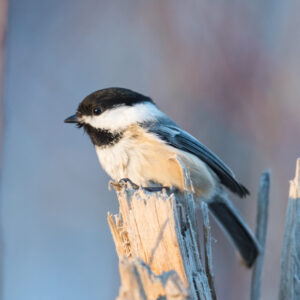Meet the Arctic Fox, the warm-blooded critters of the cold North!
Known for their striking white fur, Arctic Foxes—fittingly nicknamed “snow foxes”—are uniquely well-suited for life in frigid temperatures. Living as far south as Canada’s northern boreal forest, all the way up to the Arctic, they are more than a match for winter, ice and cold.
In Canada, Arctic Foxes are the smallest members of the canid family (which includes wolves, dogs, and coyotes). In adulthood, they are only about 75 to 115 centimetres in length. Despite their small size, these creatures are sly predators, able to smell a seal den a mile away!
How do Arctic Foxes deal with the cold? Read on to find out.
Fantastic Fur
An Arctic Fox’s luxurious fur coat is more than just an accessory—in fact, it’s essential to their survival! It gets cold where these foxes live (up to -50°C), but they’re dressed for the weather, with thick fur that keeps their bodies at a toasty 40°C! Even their furry tails serve a purpose, acting as a blanket when they sleep (and providing balance while they’re on the prowl).
Their fur grows in between their toes, acting as snow boots and muffling their footsteps lest predators are near. In the winter, the whiteness of their coats makes it difficult for bears, wolves and hungry birds of prey to spot them. Depending on the time of year, Arctic Foxes can also turn brown, gray, or even blueish, which allows them to blend in with other seasonal tundra colours.
Life in the Den
Like insulative fur, an Arctic Fox’s den is another key to survival. These surprisingly excellent diggers can create burrows as far as two to three-and-a-half metres underground, with up to 100 entrances.
During a particularly bad stretch of weather, or during a series of unsuccessful hunting excursions, Arctic Foxes take their cue from winter’s sleepiest survivors… bears! So long as they’re warm in their dens, these foxes can hibernate like bears for short periods of time by slowing down their metabolism and heart rates. These dens are so crucial, Arctic Foxes will use the same hideout for generations! Some dens that have been discovered are 300 years old.
Once Arctic Foxes awaken from their slumber, lemmings better beware. Although lemmings are their favourite snack, Arctic Foxes will also eat other rodents, birds, fish, berries, or insects. If things get desperate, they’ll even eat vegetables and scavenge for bear leftovers.
Threats to Arctic Foxes
In addition to the cold, Arctic foxes are up against a few other threats, such as inadequate food supply, hunters, and diseases like rabies and mange.
Want to help Canadian species like the Arctic Fox and more? Stay tuned with the latest in Canadian nature by subscribing for email updates. You’ll receive regular updates about what we’re doing to protect Canadian nature and how you can help.



